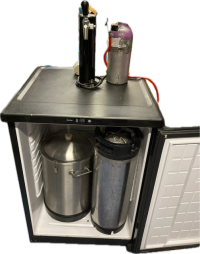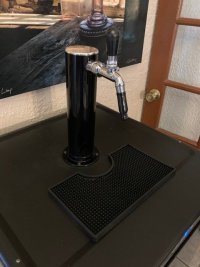That's overkill on the overkill. And then some more overkill. You really don't need anything fancy to clean the beer lines. A soda bottle with a carbonation tee works fine to push cleaning and sanitizing solution through the lines (as frequently or infrequently as you like).
Seems like something other than line length might be the issue. Maybe the beer is overcarbonated? Or maybe your serving pressure is too high?
And this is why I ask the questions

So I won't bother buying a tonne more line then, I'll just get a couple of the precut 5.5' lines so I have a couple spare and one for the other keg. Thank you.
I've tried to keep the C02 tank at 12psi, it hasn't had any fluctuation that I've been able to see so far. However, I did burst it for about 24hrs at 30psi before i got the keg in the fridge. But I relieved the pressure and then set it to 12psi after that. Would that of done it?
I've seen this happen again and again on here: Someone does all the reading and puts together a kegerator or keezer and wanting to make it the best they can and try and get in front of any problems before they happen, will buy a FC tap or the more recent FC disconnects (or even both just to cover all the bases) and then spend days, weeks or even months troubleshooting an overcomplicated system. There seems to be some unspoken notion that FC taps are somehow "Better"...Please let me be very very clear about this: They are not "Better", they are a solution to a non-standard beer dispensing system. You have the required 5.5' of 4mm ID EVABarrier therefore most beers (with the only exception being higher carbed beers) WILL pour properly out of a standard tap. The link
@mac_1103 provided is a good deal, but like he said: changing lines is overkill on overkill...One of the best features of EVABarrier is that it doesn't break down and need replacing anywhere near as often as the vinyl stuff...it lasts for years with only cleaning. Here's what I clean mine with:
https://www.morebeer.com/products/beer-line-cleaning-kit.html (however I just use hot PBW instead of BLC..both good choices) many folk like these:
https://www.morebeer.com/products/ball-lock-line-cleaning-kit-mini-party-pump.html
https://www.morebeer.com/products/carbonation-ball-lock-cap-tee-fitting.html (I used to use this one)
My best advice is to first get your system operating to the long established standards before worring about FC. If you don't have a regular tap, here's a couple:
https://www.morebeer.com/products/nukatap-beer-faucet-stainless-steel.html
https://www.morebeer.com/products/perlick-faucet-630ss-stainless-steel.html
If, with a regular disconnect through 5.5' of 4mm line to a regular tap the beer is foamy, then you have overcarbonated beer (or a bad diptube o-ring in the keg).
Please: Do yourself the service of getting it operating in the standard manner and
then you can experiment with flow control once you have made higher carbed beers that
might require it.

You did mention earlier in the thread about the flow control and how people do get foamy beers. I didn't heed it when I had the tap that hooked right on the keg, as the pours were fine from that mostly. A few did get foamy, but I think that was due to me rushing to get the beer from keg to glass without any tilt on the glass

Since you guys have taken the time to help answer my questions and provide me with plenty of things that can help, I can't disagree with any of it. And more importantly, I appreciate all of it.
So I'll be grabbing a cleaning kit instead of changing the line every keg change.
I'll also get a non FC tap to mess about with, will grab a nukatap as I like them. (found two attached to an insulated tower below

)
Will also experiment more with things to see how it all goes.
Oops! Here I go with an extra post again because I forgot to (possibly) address that part.

When you say "Some pours" Does that mean after some time has passed? ie: Is the first pour foamy, but if you do 2 in a row, the second is fine?..if so; how much time has passed between? One big issue I have with every kegerator and standard tower manufacturer is that they ship towers that have no insulation in the area where it is most needed and the tap warms up.
Fellow member
@hilljack13 is another recent kegerator owner and here's a tip I shared about insulating your tower:
https://www.homebrewtalk.com/threads/plugging-the-tube-hole-in-kegerator.735952/#post-10451217
In the 3rd picture in that post, there is my tower-cooling tube that circulates cold air from the evaporator to keep the tower and taps cool..do you have any such?..If not, I highly recommend this tower cooler:
https://www.morebeer.com/products/draft-tower-fan-kit.html
A warm tap will produce foam and depending on how warm, you may need to pour a whole pitcher just to cool down the tap. "Completing" the insulation in your tower and recirculting the warmer air out of it will solve this issue...(if you have this issue)
And to answer this one:
I haven't poured two in a row, as I'm the only one drinking it. I think my wife would look at me funny if i poured myself two pints at once

But in all seriousness, I haven't tried this and I will do so tomorrow night and see what happens.
I'll take a pic of the first and second pour too, see what everyone here thinks.
Generally it's the second pour i do, after finishing up the first, that is often more foamy than the first. I'd say about 30-45 minutes between them.
I think there's probably a mixture of things that need looking at overall. One being my pour technique (as I mentioned before, I can pour from a can or bottle and keep the top of the glass foam free with ease. But the tap isn't quite as simple. I think my angle isn't small enough to start it out, practice makes perfect).
Then there's potentially the over carbonation. But the beer doesn't taste like it's too bubbly. My second from last bottled batch was over carbonated in the bottles and that was the most gassy beer I've ever drank. Every bottle rushed out of the top like a volcano when it was opened. That was over carbonated

But again, that was sugar in a bottle. This is C02, which I'm new to, so there's new methods to learn and perfect. So if C02 gives a different type of over carbonation, then that may be what I'm experiencing and just not able to tell because of lack of experience.
Then there's tower insulation. Currently my tower only has an o-ring and insulation on the tower top cap, so since I'm currently hunting for a tower for two taps, I'll see if I can find one that's already insulated. Save me the time and it'll hopefully be done nicer than I could do it.
This one looks like it'll fit the bill nicely:
https://www.williamsbrewing.com/Hom...unts/Intertap-Double-Complete-Stainless-Tower
It's insulated and has two nukataps without FC on.
Please: Do yourself the service of getting it operating in the standard manner and then you can experiment with flow control once you have made higher carbed beers that might require it.
This is probably the best piece of advice overall and what I plan to do with my next few months of experimentation on setup.
And seriously, all of you, thank you for guiding or pointing me in the right direction on this little journey.












![Craft A Brew - Safale S-04 Dry Yeast - Fermentis - English Ale Dry Yeast - For English and American Ales and Hard Apple Ciders - Ingredients for Home Brewing - Beer Making Supplies - [1 Pack]](https://m.media-amazon.com/images/I/41fVGNh6JfL._SL500_.jpg)


















































